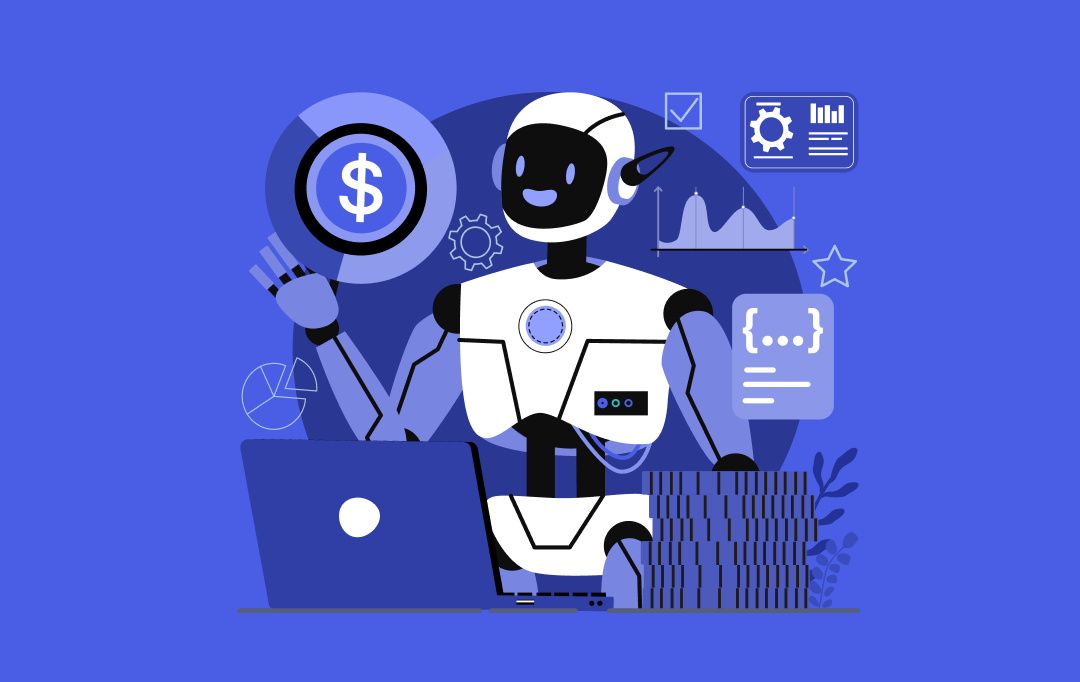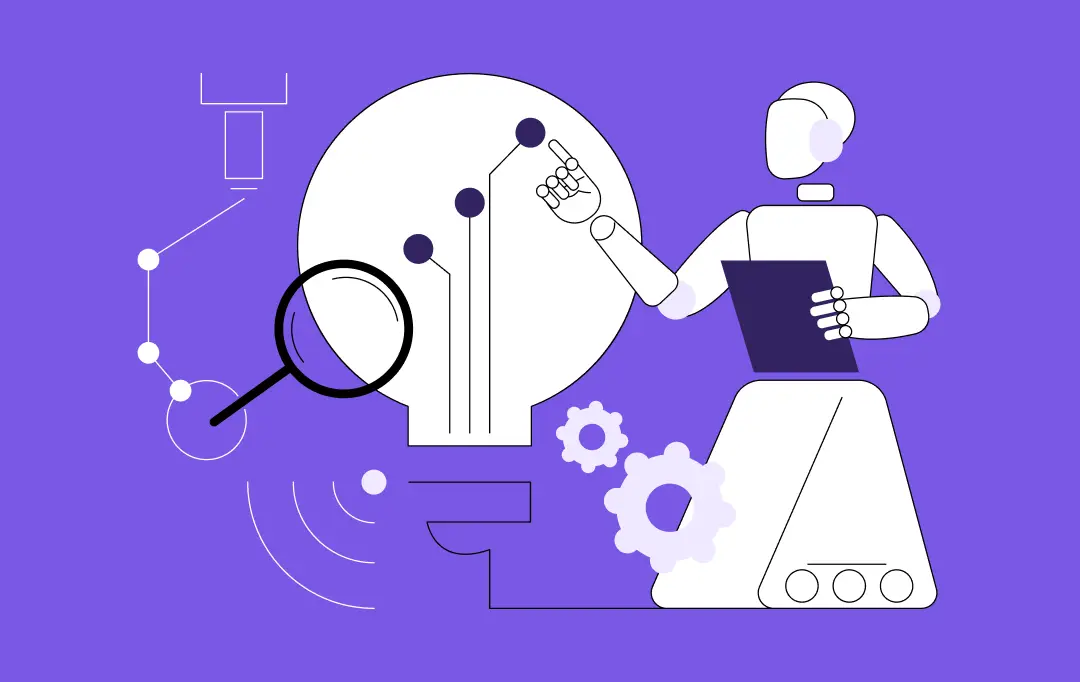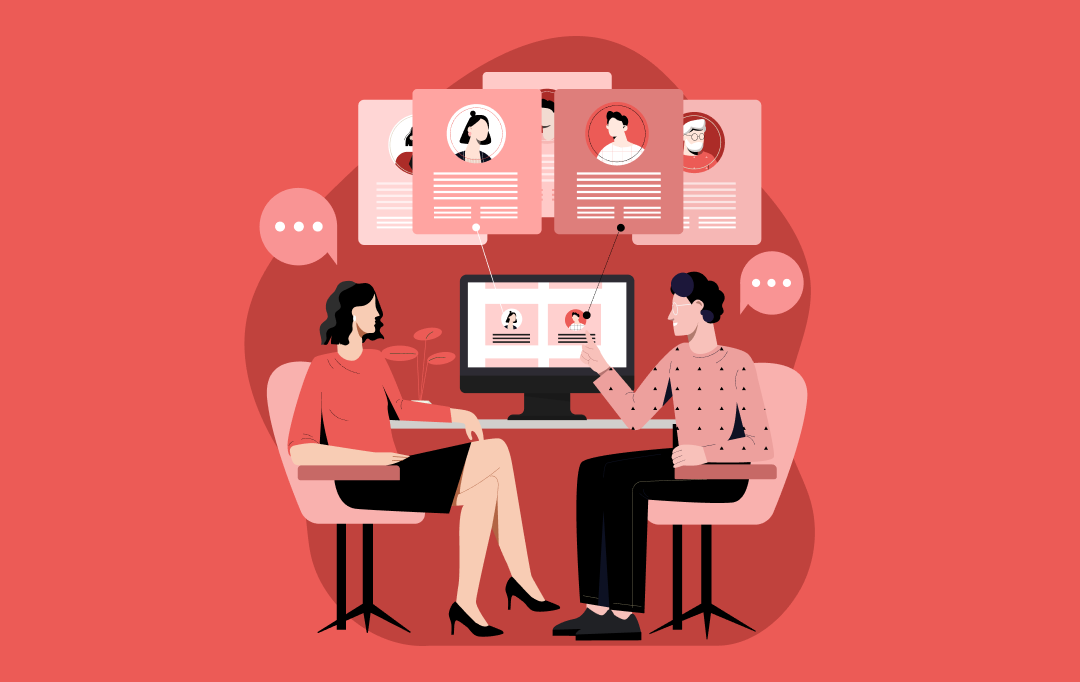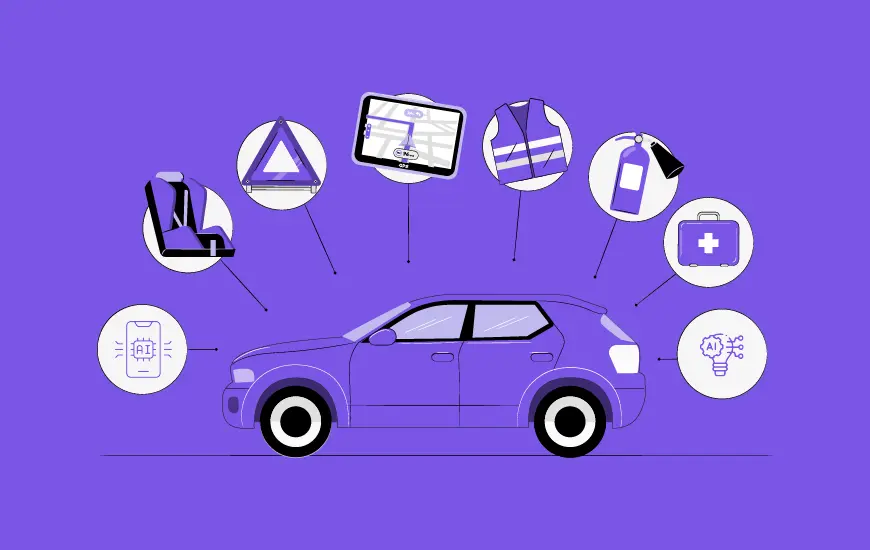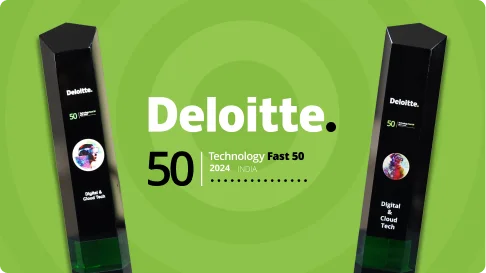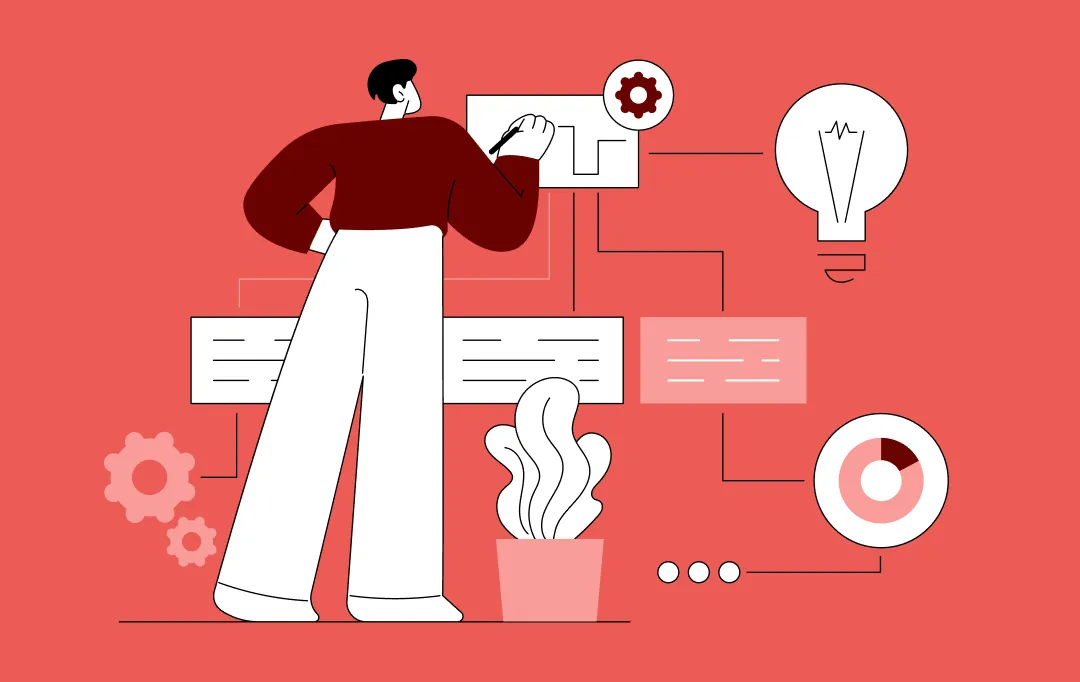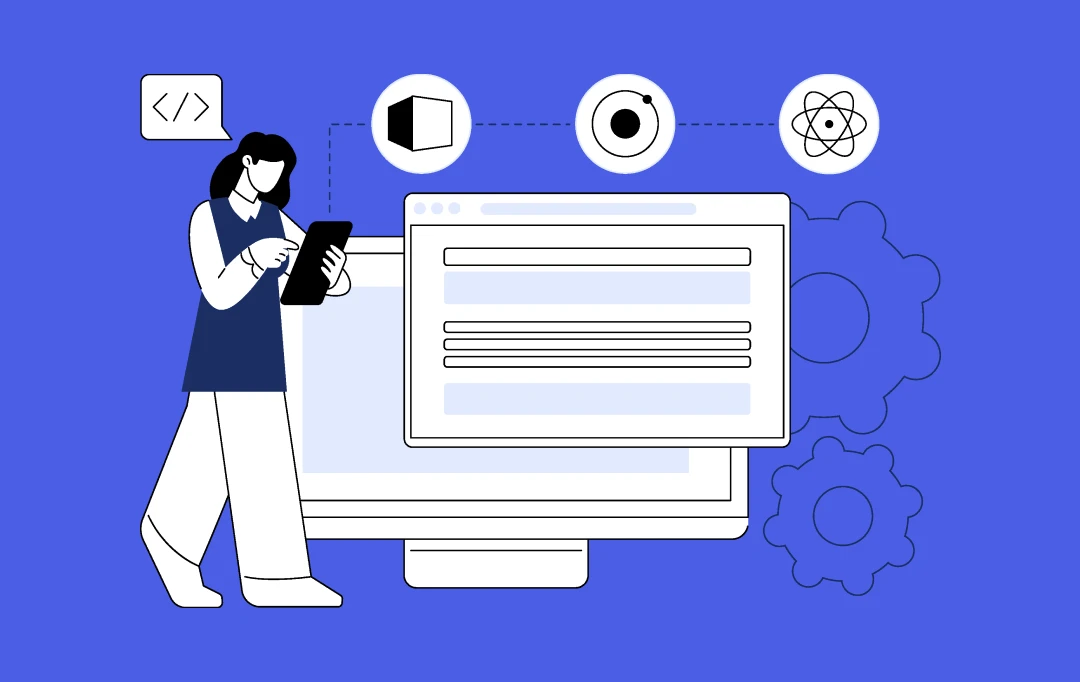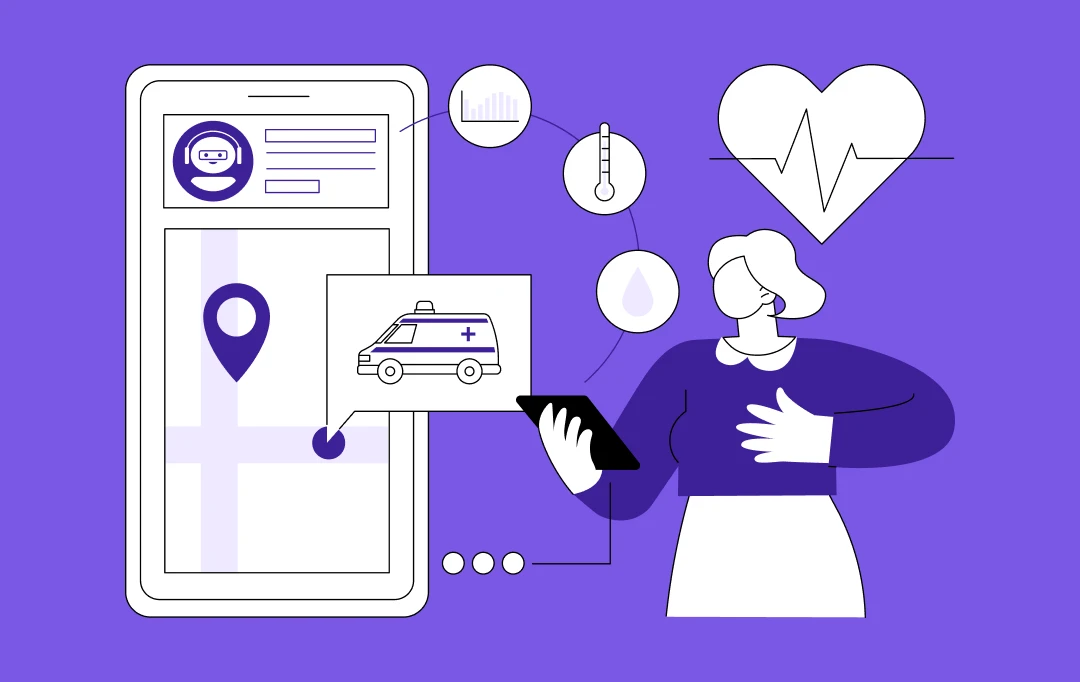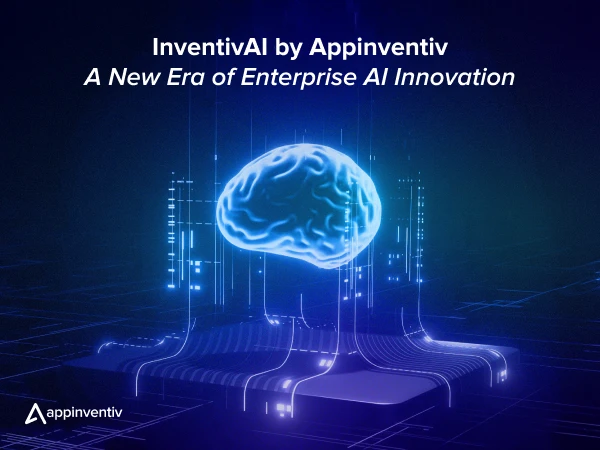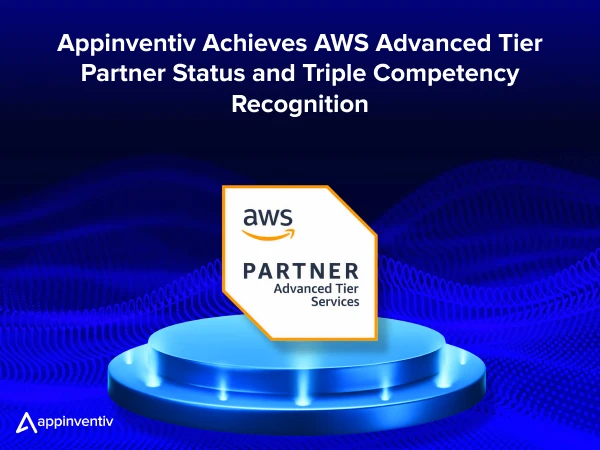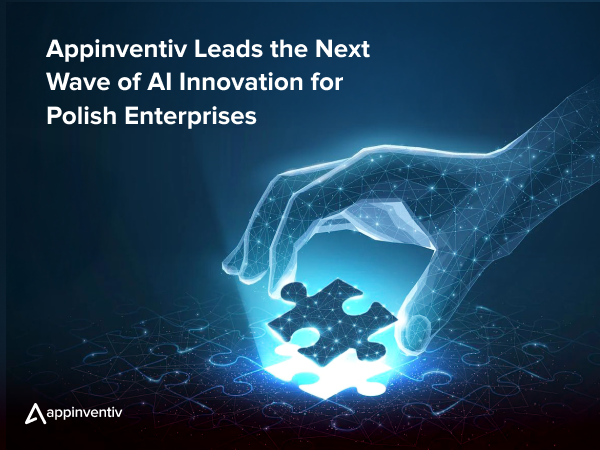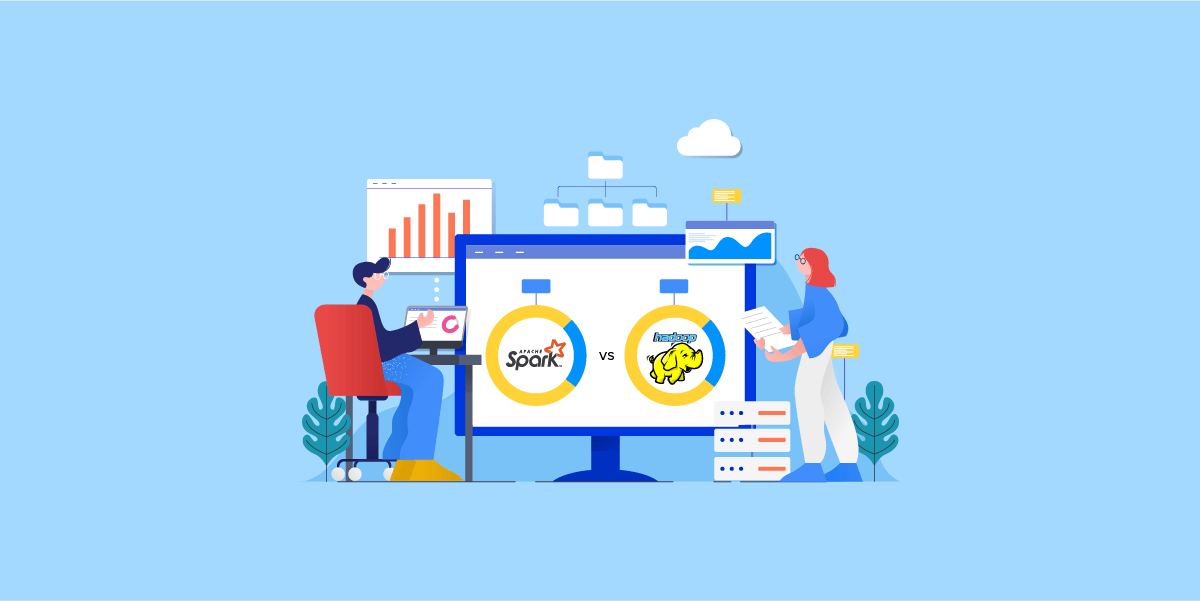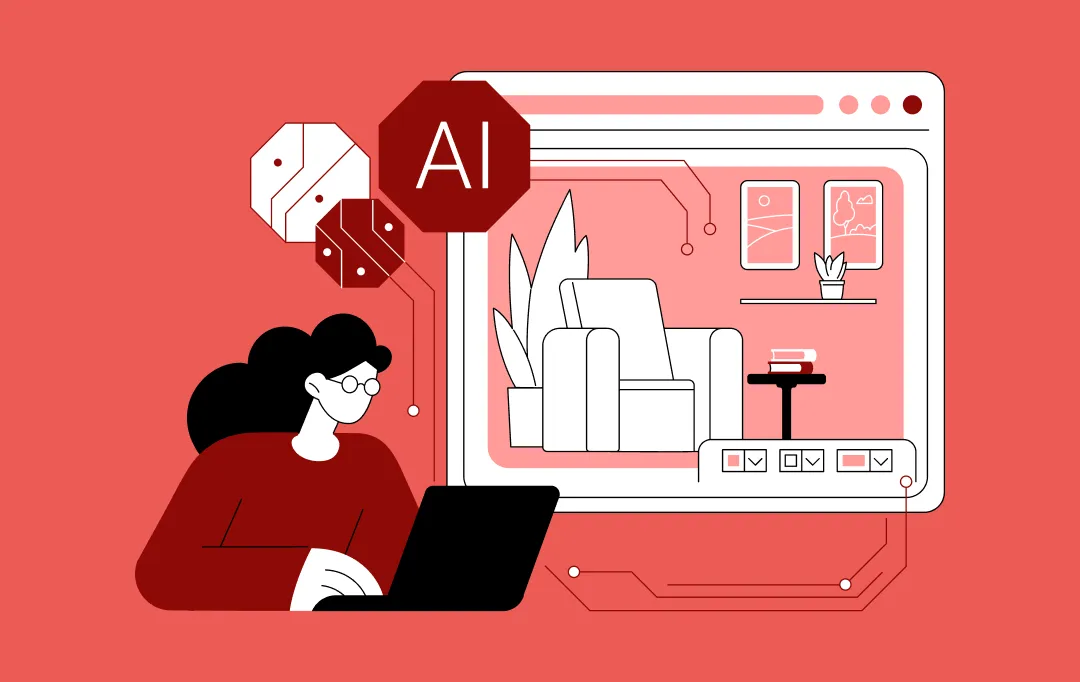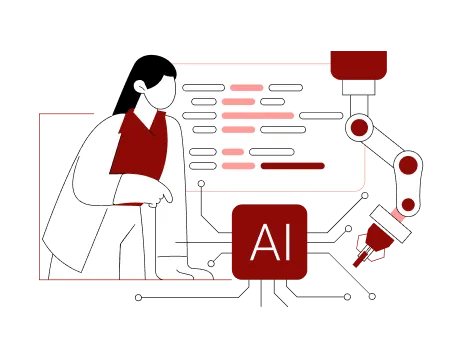- The Market Momentum Behind Artificial Intelligence Readiness
- What Is AI Readiness: A Glimpse into the Technicality
- Core Dimensions of Business AI Readiness
- Why Do Businesses Need an AI Readiness Checklist?
- Helps Identify the True Starting Point
- Prevents Costly Missteps and Rework
- Strengthens Leadership Alignment and Confidence
- Builds a Culture of Preparedness and Accountability
- Creates a Sustainable Competitive Advantage
- The Core Dimensions That Shape AI Readiness
- 1. Strategic Alignment
- 2. Data Readiness
- 3. Technology and Infrastructure
- 4. People and Skills
- 5. Governance and Ethics
- 6. Culture and Change Readiness
- 7. Measurement and Adaptability
- Turning Readiness Into Action: The Checklist
- 1. Strategy and Leadership Alignment
- 2. Data Readiness
- 3. Technology and Infrastructure
- 4. People and Skills
- 5. Governance and Risk
- 6. Culture and Change Readiness
- 7. Measurement and Adaptability
- Building an AI Readiness Framework and Methodology
- 1. Set the Foundation
- 2. Choose a Scoring Method
- 3. Run a Cross-Team Review
- 4. Turn the Framework Into a Roadmap
- 5. Revisit, Don’t Archive
- Steps to Improve AI Readiness
- Step 1: Define the “Why” Before You Touch the “How”
- Step 2: Get Your Data in Shape Before Anything Else
- Step 3: Equip Your People, Not Just Your Systems
- Step 4: Build Guardrails Before You Build Models
- Step 5: Pilot Small, Learn Fast, Scale What Works
- Step 6: Keep the Habit Going
- The Mistakes That Quietly Kill AI Readiness: Understanding the Challenges
- The Future of AI Readiness: What Comes Next
- From Adoption to Adaptability
- The Rise of Responsible AI
- The Human-Centric Advantage
- Building Connected Ecosystems
- Continuous Readiness as a Way of Working
- Why Appinventiv Is the Right Partner for Your AI Readiness Journey
- FAQs
- AI readiness is an ongoing process, not a milestone.
- Strong data, leadership, and culture drive AI success.
- A readiness checklist helps identify real capability gaps.
- Ethical and responsible AI use builds long-term trust.
- Appinventiv helps businesses move from planning to action.
- Continuous learning keeps your AI strategy future-proof.
Let’s be honest, most companies are still stuck talking about AI instead of using it. Every week, someone in your leadership team probably brings it up, and the conversation ends with “we’ll explore it next quarter.” Meanwhile, competitors are already training their systems, cutting down costs, and building smarter customer experiences. That gap isn’t about technology anymore but about AI readiness. And right now, every month you wait is a month you fall behind.
Before you start any big AI push, it’s worth asking: Is your business really ready for it? That’s where an AI readiness assessment comes in. Think of it as a reality check which isn’t about whether AI sounds exciting, but whether your data, teams, and workflows can actually support it. The best assessment for AI readiness doesn’t just measure software and servers; it looks at leadership alignment, cultural openness, and business vision. Without that foundation, no amount of funding or hype will make adoption stick.
Here’s the catch: being ready for AI isn’t just about installing tools or hiring data scientists. It’s about creating a structure that allows AI to live and grow inside your business. That’s what a solid AI readiness framework is meant for. It brings together your organizational readiness evaluation, your AI data readiness, and your long-term business plan into one direction. When that alignment happens, innovation stops being a buzzword and starts becoming part of daily work.
If you’re reading this and wondering whether your company can make that leap, this guide will help you find out. We’ll walk through what true business AI readiness looks like, how to build an actionable AI readiness checklist, and which assessment methodology actually works in real business conditions. By the end, you’ll see that readiness isn’t about preparing for the future but about deciding to own it.
Global AI spending is set to hit $632 billion by 2028, and every delay in readiness widens the gap.
Let’s find out where your organization stands and how you can catch up fast.
The Market Momentum Behind Artificial Intelligence Readiness
If you’re questioning if this matters for your organization – it does, and here’s why. According to PwC, globally, artificial intelligence could contribute as much as $15.7 trillion to GDP by 2030, a roughly 14 % uplift.
Meanwhile, IDC forecasts that worldwide spending on AI, including AI-enabled applications, infrastructure and services will grow from around $235 billion in 2024 to about $632 billion by 2028.
Together, these numbers deliver a clear message: being late to invest in organization AI readiness assessment is not just a delay in technology but a drift in competitiveness.
Here’s how that plays out for your leadership team:
- When you run an assessment for AI readiness, you’re not just assessing technology, you’re sizing up your capacity to participate in a multi-trillion-dollar shift.
- When you build an AI readiness framework, you’re aligning your strategy, data, culture and operations to the value highlighted by major research firms.
- When you assemble an AI readiness checklist and embed it, you’re safeguarding your ability to capture value before the market windows close. At this pace, the gap between “thinking about AI” and “being AI-ready” is what separates the leaders from the laggards.
In short: the figures aren’t abstract. They are a beacon. The market isn’t asking whether your company might explore AI but expects you to be ready. That’s why now is the moment for action, not hesitation.
What Is AI Readiness: A Glimpse into the Technicality
Before you jump into implementation or investments, it’s important to pause and understand what AI readiness actually means. In simple terms, artificial intelligence readiness is the state of being equipped strategically, technically, and culturally to integrate AI into everyday business operations. It’s not about having a few machine learning models or AI tools; it’s about whether your organization has the right mindset, data foundation, and governance to make AI scale sustainably.
An effective AI assessment gives leadership a snapshot of how mature your systems, teams, and processes are in adopting and managing AI initiatives. It looks at whether your enterprise has the infrastructure to deploy models, the talent to manage them, and the ethical and legal frameworks to operate responsibly. This is why so many businesses now treat organizational AI readiness evaluation as the starting point for digital transformation.
The goal of every AI readiness framework is to connect people, data, and technology under one vision, so that AI isn’t a one-off experiment, but a growth enabler across every function.
Core Dimensions of Business AI Readiness
| Dimension | What It Represents | Why It Matters |
|---|---|---|
| Strategy & Vision | Alignment of business goals with AI initiatives | Ensures AI investments support measurable outcomes |
| Data Readiness for AI | Quality, accessibility, and governance of organisational data | Clean, structured, and secure data is the foundation of all AI systems |
| Technology & Infrastructure | Scalable, secure architecture capable of supporting AI workloads | Enables seamless integration and experimentation |
| Talent & Skills | Workforce capability and understanding of AI | Drives adoption and reduces dependency on external vendors |
| Governance & Ethics | Policies for data privacy, fairness, and compliance | Builds stakeholder trust and regulatory confidence |
| Culture & Change Readiness | Willingness of teams to adopt new technology | Determines how fast AI can become a core business habit |
After understanding these dimensions, the next logical step is to see how your company performs across them. That’s where an AI readiness checklist becomes essential. It turns abstract ideas like “we’re not ready yet” into tangible indicators that can be measured, tracked, and improved. But before we dive into what that checklist looks like, let’s take a step back and understand why it matters and how it can save your organization from wasted effort, missed opportunities, and costly mistakes.
Why Do Businesses Need an AI Readiness Checklist?
Before diving into AI, every company needs an honest look at where it stands. That’s what an AI readiness checklist does. It gives leadership a clear picture of whether their data, people, and systems are ready to support AI at scale. Think of it as a health check for your organization’s future. Without it, you’re guessing, and guessing with AI usually ends up being expensive.
An Artificial Intelligence readiness assessment or organizational AI readiness evaluation helps you understand not just your technology gaps but also how well your strategy and culture are aligned with AI adoption. The checklist brings together the practical side of the AI readiness framework into one structured view. It’s not about slowing things down; it’s about moving forward with clarity and control.

Helps Identify the True Starting Point
Every business wants to say it’s ready for AI. Few actually are. The challenge isn’t interest; it’s understanding where to begin. A readiness checklist gives you that starting point. It shows whether your company’s data readiness for AI, technical AI maturity, and internal capabilities are strong enough to build on. Once you see the real picture, it becomes easier to plan the next steps and prioritize what matters. Instead of spreading effort thin, you know exactly where to focus resources and leadership attention.
Prevents Costly Missteps and Rework
AI projects often fail not because the technology doesn’t work, but because the foundation wasn’t ready. Teams rush into pilots without fixing data governance issues. A structured AI readiness assessment framework prevents that. It lets you test the strength of your infrastructure, compliance practices, and risk controls before deployment. That early discipline saves months of rework and unnecessary spend. When your systems and teams meet the benchmarks for enterprise AI readiness, implementation becomes smoother and far more sustainable.
Strengthens Leadership Alignment and Confidence
AI isn’t a departmental project; it’s a leadership decision. When every senior leader looks at the same Artificial Intelligence readiness model, there’s no confusion about priorities or progress. The checklist makes readiness visible. For instance executives can see where the company is strong, where it’s vulnerable, and what needs to be done next. That alignment builds confidence. It shifts AI from being “something IT is doing” to a shared strategic focus across business units. This is what true business AI readiness looks like – a clear direction, owned by everyone at the top.
Builds a Culture of Preparedness and Accountability
Technology readiness is only half the story. The other half is cultural. A checklist sparks conversations between departments that rarely talk like IT, data, marketing, operations, and legal, forcing collaboration around a common goal. Over time, this creates a culture that values data, experimentation, and ethical decision-making. When people understand how their role connects to AI outcomes, they naturally take ownership. That sense of accountability makes adoption faster and far less disruptive.
Creates a Sustainable Competitive Advantage
Getting AI right early doesn’t just help you run better; it helps you stay ahead. Research from PwC and McKinsey shows that organizations with mature AI readiness strategies outperform others in profitability, innovation speed, and operational efficiency. They don’t just adopt tools; they evolve their business model around them. By running a Gen AI readiness assessment and embedding continuous evaluation, you create an edge that compounds over time. The sooner you’re ready, the longer you lead.
The Core Dimensions That Shape AI Readiness
Before you even think of building anything with AI, you need to know what readiness actually looks like. It’s not a tech checklist. It’s a mix of habits, systems, and choices that together decide whether AI can live inside your business and grow with it. These are the main pieces that make up real Artificial Intelligence readiness.
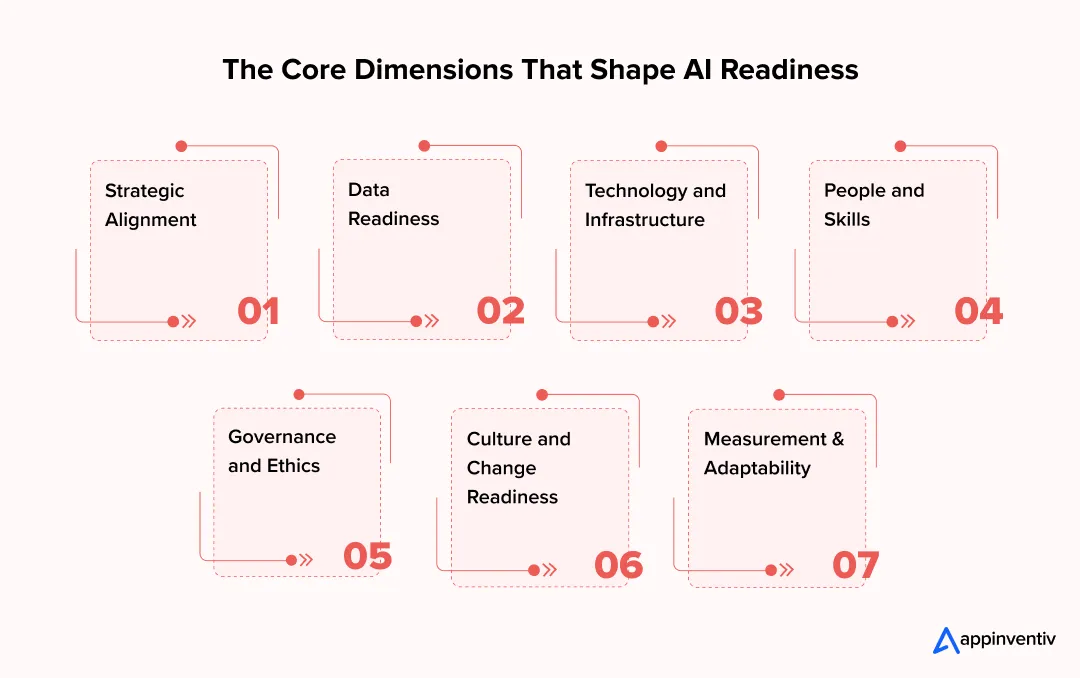
1. Strategic Alignment
AI needs a reason to exist inside your company. It can’t be another experiment running on the side. The leadership team should know why it matters, how it fits into the company’s goals and how it connects to growth, efficiency, or customer value. When that purpose is clear, decisions become easier, funding gets consistent, and people know what they’re working toward. That’s the starting point of every AI readiness strategy.
2. Data Readiness
AI depends on data, not luck. And the truth is, most organizations don’t have their data house in order. You can’t build strong models on scattered or outdated information. Data readiness for AI means knowing where your data comes from, how accurate it is, who owns it, and how easily it can be used when needed. The cleaner the data, the faster your projects move and the less you spend fixing things later.
3. Technology and Infrastructure
This is where most teams stumble. If your systems are slow, disconnected, or built on legacy tools, AI adoption turns into a struggle. Readiness here means your infrastructure can handle new workloads without constant manual fixes. It’s having a setup that lets you test, deploy, and scale AI without breaking the old systems that still keep your business running. That’s what people mean when they talk about enterprise AI readiness – being able to grow without chaos.
4. People and Skills
AI isn’t just a technical shift; it’s a mindset shift. You can have the best tools and still fail if your teams don’t understand how to use them. Real organizational AI readiness starts with people who know how to spot opportunities for AI and work with data instead of fearing it. Upskilling doesn’t need to be fancy, it just has to be practical, something that makes employees more confident, not more confused.
5. Governance and Ethics
AI without boundaries is risky. It can create bias, privacy issues, and compliance headaches before anyone notices. That’s why every generative AI readiness framework should include a basic system for governance, a way to track what data goes in, what comes out, and how those results are used. This isn’t about adding red tape; it’s about protecting trust.
6. Culture and Change Readiness
The hardest part isn’t the code. It’s the people. When employees feel threatened by AI, progress slows down. When they feel included, things move fast. Cultural readiness means being open to learning, testing, and improving together. Change management isn’t about fancy slides but about honest conversations and visible support from the top.
[Also Read: How AI is Transforming Employee Experience and Boosting Engagement and Productivity]
7. Measurement and Adaptability
You can’t improve what you never measure. Readiness assessment for AI is not a one-time event. It’s a loop. You test, learn, and adjust. Set small metrics that tell you if your strategy is working. Review them often. Readiness is something you maintain, like fitness, not a certification you earn once and forget.
Turning Readiness Into Action: The Checklist
Now that you know the main pieces that make up readiness, let’s make it real. This isn’t a formal audit. It’s a way to have an honest look at your business before you dive into AI.
Treat AI transformation readiness for businesses like a conversation starter – you can go through it with your leadership team and see where you stand. The more boxes you can check with confidence, the smoother your AI journey will be.
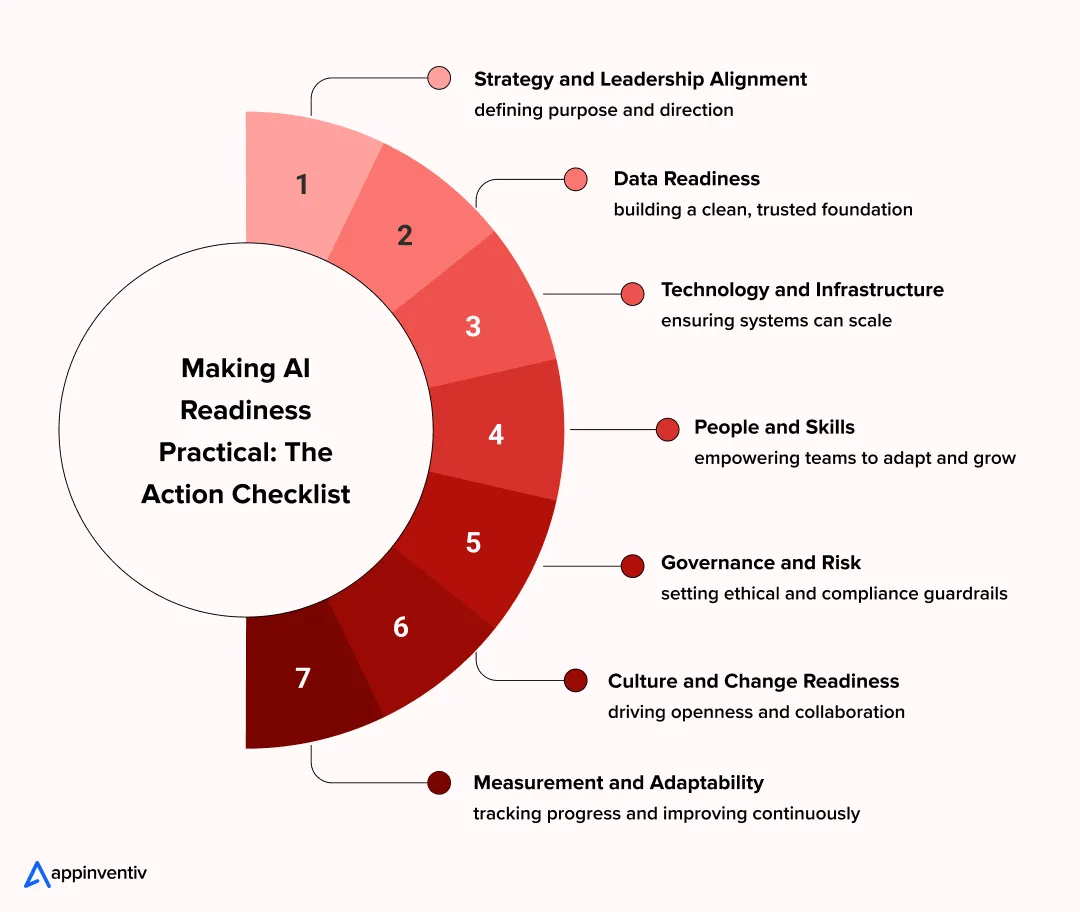
1. Strategy and Leadership Alignment
Start with the basics. Why are you building with AI in the first place?
If that answer isn’t crystal clear, everything that follows will feel scattered.
Ask yourself:
- Do we have a written plan that connects AI to our business goals?
- Is there someone on the leadership team who owns the AI roadmap?
- Have we agreed on what success looks like – more efficiency, better service, new products?
If these questions feel uncomfortable, that’s your cue to pause. Strategy before spending.
2. Data Readiness
AI is as strong as the data that feeds it. If your teams don’t trust the numbers, neither will the models.
Check a few simple things:
- Do we know where our data comes from and who’s responsible for it?
- Is it clean, consistent, and easy to reach when we need it?
- Are privacy and compliance already part of how we handle data, not an afterthought?
When these pieces fall into place, data readiness for AI stops being a barrier and starts becoming your biggest advantage.
3. Technology and Infrastructure
Here’s where reality hits. You can’t build modern AI systems on outdated plumbing.
Ask these:
- Are our systems connected, or do we still move files around manually?
- Can we scale without crashing budgets or performance?
- Do we have the security layers to protect sensitive data and models?
If the answer is “sort of” or “not yet,” that’s fine. It just means your assessment for AI readiness needs to start here.
4. People and Skills
AI doesn’t replace people; it amplifies what they can do. But only if they understand it.
Think about this:
- Have we trained teams on what AI can and can’t do in their daily work?
- Do we have internal talent who can manage projects instead of outsourcing everything?
- Are employees part of the conversation, or are they just being told what’s coming?
Real organizational Artificial Intelligence readiness happens when people feel involved, not imposed upon.
5. Governance and Risk
This one’s about trust. AI is powerful, but it needs guardrails.
Run through this short list:
- Is there a clear process for checking bias, privacy, and fairness?
- Do we track how AI systems make decisions and who approves changes?
- Have we defined what “ethical use” actually means inside our company?
These aren’t buzzwords but are the things that keep your business out of trouble later.
6. Culture and Change Readiness
Even the best plan fails if the culture isn’t ready. People fear what they don’t understand, so talk about AI early and often.
Ask:
- Do employees know why we’re bringing in AI, not just that we are?
- Is leadership open about how roles might evolve?
- Do we celebrate small wins when new tools make work easier?
Culture is what decides whether AI sticks or fizzles out.
7. Measurement and Adaptability
Readiness isn’t a one-time check. It’s something you keep working on. The moment you stop measuring, things slip.
Review regularly:
- Are we tracking results from each AI project like ROI, adoption, or impact on quality?
- Do we update our AI readiness framework as the business evolves?
- Are we learning from what didn’t work just as much as from what did?
That’s how readiness grows – quietly, steadily, and with accountability.
Our team helps businesses turn readiness reports into working systems, from data to deployment.
If you’ve mapped your gaps, we can help you close them.
Building an AI Readiness Framework and Methodology
Once you’ve gone through the checklist, the next question is simple: how do you keep track of it all? That’s where a framework comes in. A good AI readiness methodology and framework isn’t a thick report or a one-time audit. It’s a structure that helps you measure progress, spot weak spots, and see how prepared your organization really is to scale AI. Think of it like an ongoing scoreboard for your assessment for AI readiness, something you revisit as your business evolves.
The goal isn’t to build something perfect. It’s to build something useful -a system that grows with your company instead of locking you into a single snapshot.

1. Set the Foundation
Start by picking the areas that matter most for your organization. You don’t need to track twenty metrics on day one. Focus on five or six core pillars, things like strategy, data readiness, technology, people, governance, and culture. For each one, define what “ready” looks like. Keep it practical.
Example:
- Strategy: “We have an approved AI roadmap and funding plan.”
- Data: “Key business datasets are cleaned and accessible through one source.”
- People: “Each department has at least one trained AI champion.”
That’s your baseline.
2. Choose a Scoring Method
Once the pillars are clear, give them a way to move. A simple 1-to-5 scale works fine, where 1 means “not ready” and 5 means “operational.”
Here’s what it might look like for AI readiness:
1 — No awareness or planning
2 — Initial discussions, no structure yet
3 — Pilots and small wins
4 — AI embedded in select functions
5 — Fully scaled with measurable ROI
You can repeat this for every pillar and get a quick visual of where you stand.
3. Run a Cross-Team Review
AI readiness isn’t owned by IT alone. Bring in voices from operations, finance, HR, risk, and customer experience. When you do a business AI readiness evaluation, you’ll notice each department sees different gaps and that’s exactly what you want. The framework works best when it becomes a shared language across departments, not a tech checklist buried in an email.
4. Turn the Framework Into a Roadmap
Numbers don’t matter unless they turn into action. Once you’ve scored your readiness, focus on the biggest gaps first.
Maybe your data is strong, but your people aren’t trained. Maybe your culture is ready, but your systems are outdated. Translate those findings into a roadmap that’s easy to communicate, something leaders can review quarterly.
This is how your AI readiness assessment methodology starts driving real change instead of sitting on a deck.
5. Revisit, Don’t Archive
Readiness isn’t a project. It’s a loop. Every few months, go back to the framework. Check what’s improved, what hasn’t, and what’s new.
Technology will shift, regulations will tighten, and your team’s comfort with AI will grow. You need to understand that updating your framework regularly keeps it alive and that’s what separates companies that talk about AI from those that scale it.
Steps to Improve AI Readiness
Once you know where your business stands, it’s time to move from awareness to action. Improving AI readiness isn’t about big speeches or big spending but about doing the small, practical things that make AI adoption smoother, safer, and actually useful.
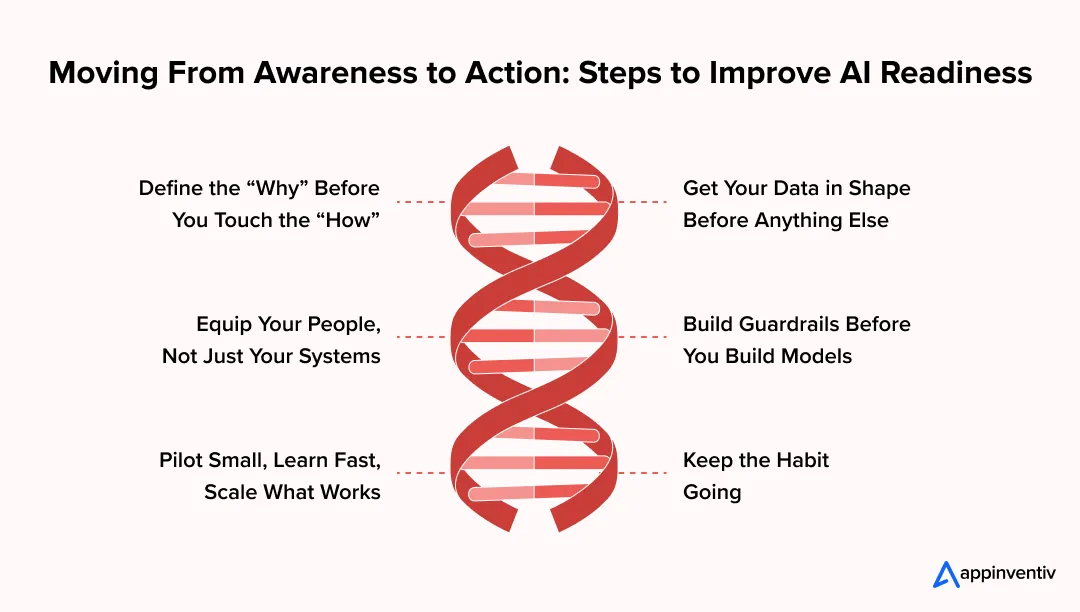
Step 1: Define the “Why” Before You Touch the “How”
Every successful AI journey starts with purpose. Pick the business problem that keeps showing up in meetings, the one everyone wants fixed but no one has solved yet. When your team knows why they’re using AI, direction becomes obvious, and so do the next steps.
Step 2: Get Your Data in Shape Before Anything Else
Messy data is like a leaky foundation and everything above it eventually cracks. Before investing in tools or talent, look at what you already have.
Where’s your data? How accurate is it? Who owns it? Cleaning this up is the first real test of data readiness for AI and it’s the step that separates those who talk about AI from those who actually use it well.
Step 3: Equip Your People, Not Just Your Systems
You don’t need an army of data scientists to start, but your teams must understand what AI means for their day-to-day work. Help them see it as a helper, not a threat. Short, focused training or even open conversations can shift mindsets faster than long playbooks. That’s where real organizational AI readiness begins – with people who get it.
Step 4: Build Guardrails Before You Build Models
AI moves fast, and mistakes move faster. Set up a light governance layer early, just enough to review privacy, fairness, and compliance. Keep it simple: one group, clear rules, short reviews. It’s the best insurance policy you’ll ever have.
Step 5: Pilot Small, Learn Fast, Scale What Works
Don’t start with the biggest challenge in the company but choose the one that you can fix quickly. A small win builds credibility and proves your readiness assessment framework is working. Once a pilot delivers value, expand it to another function. Let results, not excitement, drive scale.
Step 6: Keep the Habit Going
AI readiness isn’t something you cross off a list. Revisit it every few months. Ask: what changed, what improved, what still feels stuck? The companies that review often are the ones that keep moving forward while others get comfortable.
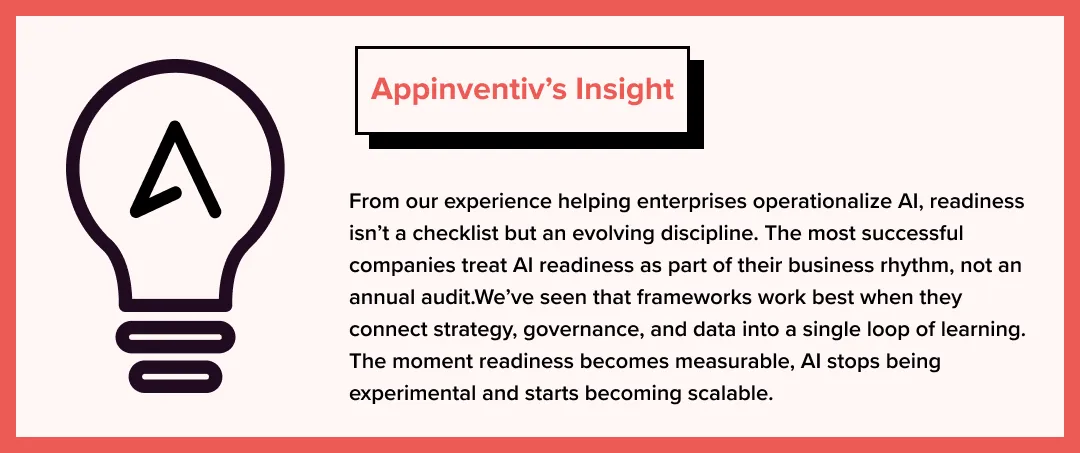
The Mistakes That Quietly Kill AI Readiness: Understanding the Challenges
Most organizations don’t fail at AI because of lack of talent or money but fail because they rush the basics, skip communication, or forget why they started. Here’s what typically goes wrong and how to steer around it.
| Pitfall | What It Really Means | How to Fix It Before It Hurts |
|---|---|---|
| Chasing AI Without a Clear Purpose | Teams jump into tools and pilots without a defined problem, ending up with scattered projects and no results. | Start with a “why.” Pick one measurable business issue AI can actually solve and then build from there. |
| Treating Data as an Afterthought | Poor data quality slows every model and confuses teams about which numbers to trust. | Run a data readiness for AI check early. Clean, label, and centralize data before you bring in new platforms. |
| No Executive Owner | Without leadership backing, initiatives drift and funding dries up. | Assign one accountable leader for AI readiness, someone who connects strategy with execution. |
| Ignoring Governance and Risk | AI readiness models go live without fairness, security, or compliance reviews. | Create a small governance board and document key decisions. Keep it simple but consistent. |
| Cultural Resistance | Employees think AI is here to replace them, not help them. | Communicate early, celebrate small wins, and show how AI makes daily work easier, not obsolete. |
| Measuring Activity Instead of Impact | Companies brag about “number of pilots” instead of real outcomes. | Focus metrics on business results such as revenue gain, time saved, or better customer experience. |
| Treating Readiness as a One-Time Exercise | Many do one only one assessment for AI readiness and never revisit it. | Make it a recurring cycle and track progress, update frameworks, and celebrate improvement. |
The Future of AI Readiness: What Comes Next
AI readiness isn’t something you achieve once and move on from. It’s a moving line that keeps shifting as technology, laws, and customer expectations change. What felt advanced last year might already look outdated today. The real question for businesses now is not “Are we ready?” but “Can we stay ready?” That’s the difference between companies that ride the next wave of innovation and those that quietly fall behind.
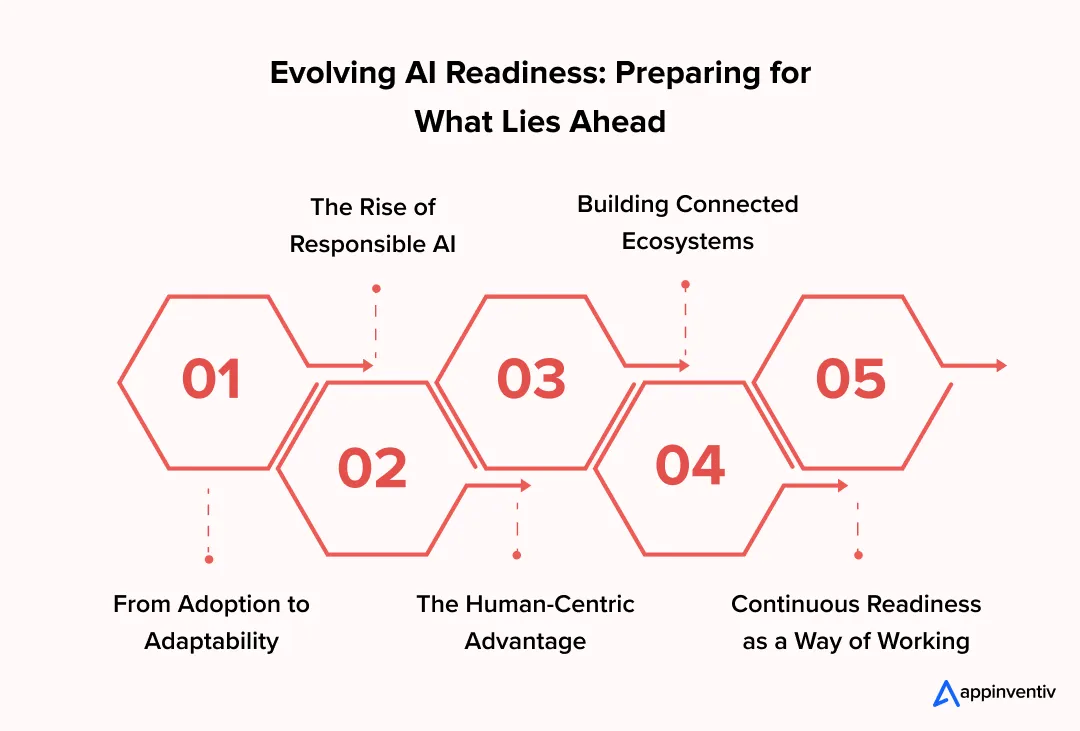
From Adoption to Adaptability
For most organizations, the early phase of AI readiness was about adoption – building data pipelines, finding the right tools, and getting buy-in from leadership. That’s changing fast. The next phase will focus on adaptability and how quickly a company can respond when models evolve or when new risks appear. Your AI readiness framework shouldn’t sit in a report; it should live and breathe with the business. The companies that build flexibility into their systems and culture will find it easier to pivot and keep up with whatever comes next.
The Rise of Responsible AI
As AI gets deeply embedded in decisions that affect people’s lives, responsibility is becoming non-negotiable. Governments around the world are setting boundaries through new AI laws and data protection acts. This means business AI readiness will soon depend not just on capability, but on credibility. Businesses will need to prove that their AI systems are responsible, explainable, fair, and compliant. Readiness in the coming years will be measured by how transparently a company can show its decisions, not just how efficiently it can make them.
The Human-Centric Advantage
Even in a world filled with automation, people remain the advantage. AI can predict, but it can’t empathize. It can be recommended, but it can’t understand culture or emotion. The next stage of business AI readiness will revolve around how well companies blend technology with human strengths like creativity, empathy, judgment, and ethics. We’ll see more focus on new roles like data translators and AI ethicists, and more investment in soft skills that complement automation. Companies that keep humans at the center will continue to innovate with meaning, not just speed.
Building Connected Ecosystems
Tomorrow’s AI won’t live in silos. It will run across networks, linking data, partners, and customers in real time. That means AI integration readiness for enterprises will extend far beyond internal databases. It’ll include suppliers, cloud partners, even regulators, all tied together through secure data-sharing ecosystems. Businesses that design for collaboration instead of isolation will scale faster and build more resilient AI systems. Integration, not ownership, will define leadership.
Continuous Readiness as a Way of Working
Finally, readiness itself will become continuous, a discipline, not a milestone. Leading organizations will treat AI adoption readiness assessment like financial reporting: a routine health check that measures capability, ethics, and resilience together. They’ll keep track of how their teams, data, and systems evolve, using those insights to stay a step ahead. In time, readiness won’t just prepare you for change but will become the way your company handles change.
The future of AI readiness belongs to organizations that learn faster than technology moves. Being ready won’t mean being perfect; it’ll mean being alert, curious, and ready to act before others do. That’s what separates those who simply adopt AI from those who shape the world around it.
Why Appinventiv Is the Right Partner for Your AI Readiness Journey
Becoming AI-ready takes more than a checklist or a roadmap. It takes a partner that can translate readiness into action, someone who understands the strategy, builds the systems, and measures the impact all the way through. That’s where Appinventiv stands apart. As an AI development services provider with years of expertise, we’ve helped global businesses not just adopt AI but integrate it into their core operations, where it drives measurable outcomes every day.
We’ve seen firsthand how readiness changes everything. Take Americana Group, for example. Their delivery network across multiple food brands was struggling with delays and poor coordination. We built a real-time command platform powered by language models that processes data instantly, automates assignments, and supports fast decisions across hundreds of locations. The result? Delivery efficiency doubled, and operational accuracy improved fourfold which is proof that the right AI foundation doesn’t just modernize systems; it transforms how the business runs.
Or consider MyExec, a client that wanted to bring smart decision-making to small businesses without the high cost of consultants. We created a multi-agent RAG system that reads documents, analyzes them, and gives personalized business advice in seconds. What started as a prototype is now a platform that keeps learning, adapting, and helping business owners make confident choices. That’s what organizational AI readiness looks like when it’s done right.
We’ve also helped brands like MUDRA and Vyrb push AI beyond the boardroom and into people’s daily lives. MUDRA turned personal finance into a conversational experience, helping users in over a dozen countries build smarter spending habits. Vyrb, on the other hand, redefined social interaction for Bluetooth wearables with a voice-first AI platform that lets users send and receive audio messages hands-free. Both projects started with the same foundation, understanding readiness, then turning it into something meaningful.
And when Flynas, one of the leading airlines needed a digital rebuild, our team redesigned their mobile experience from the ground up. We combined clean UI/UX with AI-driven booking assistance and a scalable backend built for growth. The difference was immediate, leading to higher engagement, smoother user flows, and a platform ready for whatever the next phase of digital travel brings.
These are just a few examples of how Appinventiv helps organizations move from AI ambition to AI maturity. As an AI consulting company, our approach blends strategy, design, and engineering under one roof, ensuring that every step, from data readiness to deployment, supports your long-term vision. If your goal is to build systems that don’t just work today but keep learning and improving tomorrow, we’re the partner who can make that happen.
FAQs
Q. How can businesses evaluate AI readiness?
A. The first step is to look inward. Most companies jump straight to tools or vendors without checking if the basics are ready. Evaluating AI readiness means figuring out if your data, systems, and people can actually support what you want AI to do.
Start small and be honest about where you stand.
- Look at your data readiness for AI – is the data clean, labeled, and accessible to the teams that need it?
- Review your infrastructure and understand if your systems are modern enough to connect with AI tools?
- Ask whether leaders are on the same page about what AI should deliver.
- Check if employees understand how AI will change their work, not just that it’s coming.
When you put these pieces together, you’ll know if your company’s ready to build or still needs to prepare the ground.
Q. How do consultants assess AI readiness in businesses?
A. Consultants usually start by listening more than talking. Every company has its own challenges, so the goal is to find what’s holding AI adoption back. An AI implementation readiness for enterprises from a consultant is less about scoring and more about understanding how decisions, data, and workflows really work behind the scenes.
Here’s what they usually do:
- Sit with key stakeholders to hear how leadership defines success.
- Audit systems and data to see what’s usable and what needs cleaning up.
- Evaluate existing skills to learn if your teams can handle AI once it’s deployed.
- Review governance and understand if there are policies to handle bias, compliance, and ethics?
- Create an AI readiness framework that turns all this into a clear plan for next steps.
In the end, you get a picture of where you stand and a realistic roadmap to move forward, not a theoretical report that gathers dust.
Q. What are the key factors in determining AI readiness for your organization?
A. Every business wants to say it’s ready for AI. The real test is whether your organization can use AI to create measurable value, not just experiments. True AI strategy and readiness for organizations comes down to a few simple but critical things.
- Leadership vision: Everyone at the top should share a common understanding of what AI is meant to achieve.
- Data health: Your data must be accurate, available, and responsibly governed.
- Technology strength: Systems should be scalable enough to handle AI workloads.
- People and culture: Teams need curiosity and confidence to work with AI, not fear of it.
- Ethical grounding: You’ll need a basic governance setup to keep decisions transparent and fair.
If these five areas are balanced, your organization is ready to move from talk to action.
Q. How can Appinventiv help prepare your organization for AI?
A. Appinventiv helps businesses close the gap between strategy and execution. We start by assessing your AI readiness, where your systems, data, and teams are strong and where they need work and then build a roadmap that fits your goals.
You can see the impact of that approach in the projects we’ve already delivered.
With Americana Group, we created a language-model-powered system that doubled last-mile delivery efficiency and improved operational accuracy fourfold.
MyExec used our multi-agent RAG setup to turn business documents into instant, data-backed insights for small companies that couldn’t afford traditional consulting.
Through MUDRA, we built a conversational AI platform that helps users in 12+ countries manage money better, while Vyrb gave Bluetooth wearable users a voice-first social experience that raised $1M in funding.
And when Flynas wanted a stronger digital presence, we rebuilt their app with AI-powered assistance and a smoother, high-performance design.
We don’t just integrate AI into businesses but make sure they’re ready to keep evolving with it. That’s the difference between short-term innovation and long-term intelligence.
Q. What are the steps to implement AI in an AI-ready business?
A. Once you’ve built the foundation, implementation becomes a matter of focus and timing. Enterprise AI readiness isn’t the finish line but the starting point. The best approach is to move in stages, keeping each one grounded in real business value.
- Find the right use cases. Choose areas where AI can make a visible impact fast, such as customer service, logistics, analytics, or forecasting.
- Pilot first. Run small, contained tests before scaling. Use these pilots to refine your AI readiness assessment framework in real-world conditions.
- Get your data pipelines right. Make sure your data stays consistent, secure, and compliant at every stage.
- Train your people. Help teams learn how to use AI tools confidently and interpret the results they produce.
- Keep governance in place. Ethics and compliance aren’t optional but protect trust as you grow.
- Scale slowly but steadily. Take what works and extend it to other departments with a feedback loop built in.
When these steps work together, AI doesn’t just sit in your business but becomes part of how your business thinks and grows.


- In just 2 mins you will get a response
- Your idea is 100% protected by our Non Disclosure Agreement.
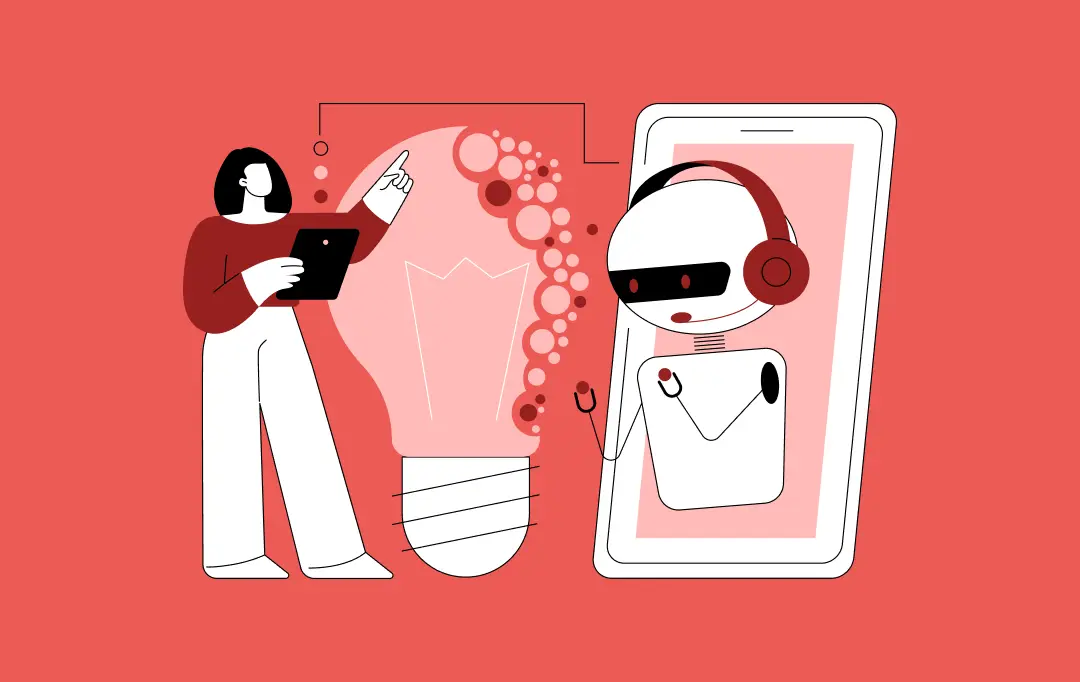
How Much Does It Cost to Build an AI App in Dubai?
Key takeaways: AI app costs in Dubai typically range from AED 80,000 for simple builds to AED 800,000+ for enterprise systems. Dubai is past AI experimentation, and not investing now means catching up later at higher cost. The real budget is driven by data, integrations, architecture, and compliance, not just app features. Hidden costs like…

How AI Tokenization is Enabling Secure and Transparent Asset Ownership in 2026
By 2026, AI tokenization has moved beyond early-stage experiments and pilot projects. Tokenizing real-world assets has become a serious commercial strategy for financial institutions, supply chain operators and technology-driven enterprises. A 2025 report by the World Economic Forum in collaboration with Accenture highlights tokenization as a key mechanism for value exchange in modern financial markets.…

13 Ways Generative AI is Transforming the Hospitality Industry
Key takeaways: The most mature applications of Generative AI for hospitality are in guest service, revenue management, marketing, and operations automation. Real value comes from integrating generative AI into hospitality operations and existing PMS, CRS, CRM, and POS systems, rather than using stand-alone tools. Successful programs treat Generative AI in hospitality as a product, incorporating…
